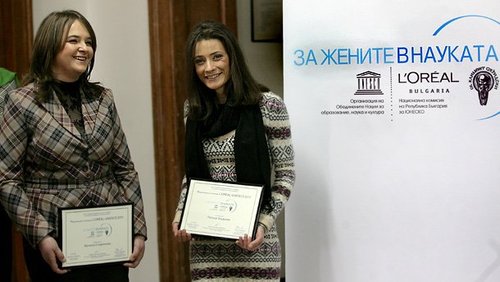UNESCO-L’OREAL Award nurtures women’s development in science
 Young Bulgarian women Ralitsa Zidarova and Vassilka Steflekova won the UNESCO-L’OREAL Women in Science Award. They were granted fellowships to the tune of 5000 euro each, aiming to support their research and further career development. Initiated by L’OREAL and UNESCO, the International Fellowship Programme for Young Women In Life Sciences is recognized in more then 50 countries worldwide. In Bulgaria, the programme has run for a second consecutive year. The official award ceremony took place under the patronage of Bulgaria’s Education Ministry.
Young Bulgarian women Ralitsa Zidarova and Vassilka Steflekova won the UNESCO-L’OREAL Women in Science Award. They were granted fellowships to the tune of 5000 euro each, aiming to support their research and further career development. Initiated by L’OREAL and UNESCO, the International Fellowship Programme for Young Women In Life Sciences is recognized in more then 50 countries worldwide. In Bulgaria, the programme has run for a second consecutive year. The official award ceremony took place under the patronage of Bulgaria’s Education Ministry.
“Science has been for centuries on end a club closed to women, and unfortunately, this is still the case in many countries”, says Education Deputy Minister Petia Evtimova. “Therefore, UNESCO and the European Commission have taken action to encourage more female participation in science. I’m happy to say Bulgaria’s science is open to women. As a matter of fact, the country is in the top rankings in Europe and elsewhere in women’s involvement in science. Historically, Bulgaria’s first female scientist was Professor Elisaveta Karamihaylova. Having lived in the first half of the 20th century, she was among the world’s first female physicists, along with famous Marie Curie and Lise Meitner. Today’s laureates represent a contemporary generation of women who continue Bulgaria’s scientific tradition. “
According to the 2009 EC report on gender equality in science, Bulgaria assumes a leading role in Europe in the number of women scientists. While in Bulgaria 45% of scientists are women, in the EU, science is still a men’s vocation, with men scientists accounting for 70%.
Ralitsa and Vassilka’s research projects competed with the works of 30 young ladies of up to 35 years only to win the praise of the UNESCO-L’OREAL professional jury. Physicist Vassilka Steflekova firmly believes that Bulgaria is not lacking in opportunities for career in science. “In the last years, more and more foundations have been funding the scientific research of young Bulgarians”, Vassilka comments. She has had the chance to join an international science project under the EU-based Marie Curie Programme. She has recently become a graduate fellow at the Institute of Solid State Physics with the Bulgarian Academy of Sciences. She won the Women in Science Award with a project for the application of a new materials analysis method through laser technologies. Her analysis method has the added advantage of being used not only for metals but also for non-conductive materials, such as ceramics and glass. This makes it extremely suitable for determining the composition and age of archeological artifacts. Vassilka is planning to use the fellowship money for buying technology and materials that can help her research.
The second Bulgarian lady who won a UNESCO fellowship is biologist Ralitsa Zidarova. She works as a head assistant at the Biology Faculty of Sofia University “St. Kliment Ohridski”. She’s taken part in 4 Bulgarian scientific expeditions to Livingston Island to research new species of flint algae. The flint algae research has brought her the Women in Science Award.
“In the area of the Bulgarian polar base, we research flint algae. They are called “flint” because this kind of algae has got a silicon substance shuck. It has turned out that our knowledge about the flint algae in Antarctica is pretty scarce because on researching the algae in the past, scientists didn’t use appropriate literature to classify them. As a result, we’ve jumbled up the species, not distinguishing at present their ecology and distribution. Therefore, we made a revision of the algae, which led to the classification of new species, wrongly identified in the past. We did the same thing in Livingston Island. The fellowship will enable me to carry on with the research. I expect more surprises in store for us”, says in conclusion Ralitsa Zidarova, awardee of the 2011 UNESCO-L’OREAL fellowship for women in science.
Text and photo: bnr.bg
(09.02.2012)